“Pichhwai for Gopashtami” has been added to your cart.
View cart
-
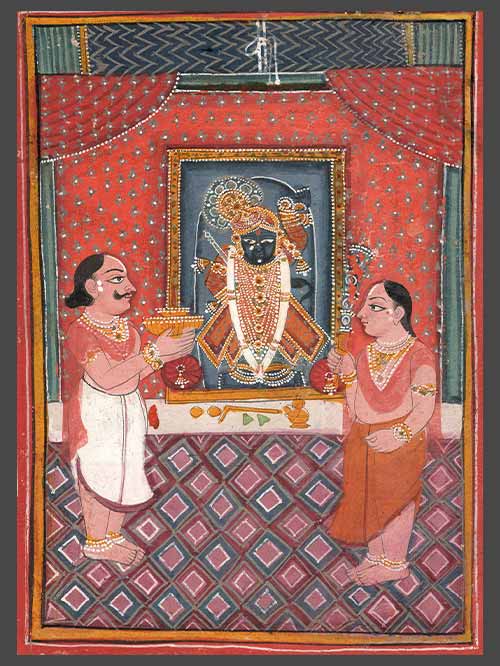
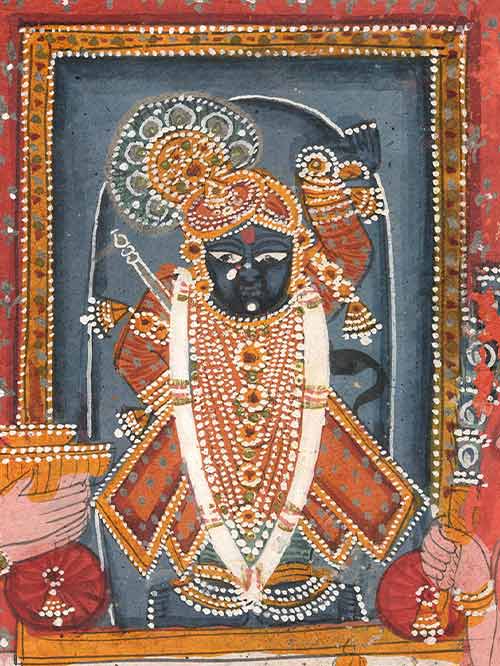
Nathdwara (Rajasthan)
Opaque pigments on paper
Srinathji wears a Chakdarwagha (coat with four pointed ends) with pyjama (trousers), a mustard upper garment, and a bejewelled raj mukuta or regal fan-shaped turban ornament. His left hand is raised to symbolize the lifting of the sacred mountain Govardhana, and he holds his cowherd’s stick (lakut). At his feet are two folded betel leaves and the jhari or covered pot of Jumna water, symbolising the ever-present love of his foster-mother Yashoda. Tilkayat Govindji and his young son Girdharji are seen on either side of Srinathji, the former carrying an arti lamp and the latter a peacock whisk. A chequered mauve and blue carpet lies underfoot, with a floral saffron pichhwai behind the deity and overhanging crimson curtains.
Painting Size (cms): 24(H) x 17(W)
Painting Size (inches): 9.5(H) x 6.5(W)
-
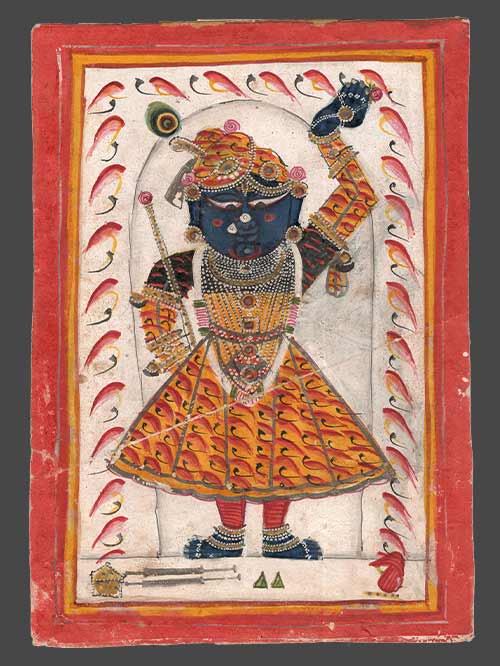
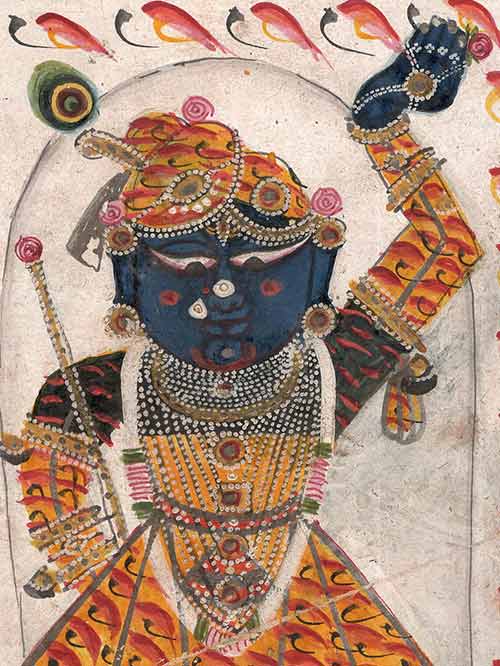
Nathdwara (Rajasthan)
Opaque pigments on paper
Shrinathji is adorned with rows of pearls and gem studded necklaces, armlets, anklets and turban ornaments. He holds with his arm around his back his cowherds stick (lakut) and a fully bloomed lotus in his left arm which is raised towards the sky. He is dressed in a saffron coat (gherdaar wagha with choli) and turban surmounted by a peacock feather plume (pagh with chandrika). His chest, shoulders and clothes are smeared with red gulal and dark lines of burnt sandalwood powder. His cheeks too are marked with red gulal. Similarly, dark lines of burnt sandalwood can also be seen on the white pichvai behind him, along with red gulal and yellow sandalwood. At his feet are the prescribed banta, or snack box, paan-bida or folded betel leaves, the covered pot of Jumna water. Two syringes filled with gulal (colour) are kept on the platform for Shrinathji to play with. This painting depicts Shrinathji in his shringar during Phalguna.
Phalguna (Spring) is the last month of the year in the Hindu calendar, usually corresponding to February/March in the Gregorian calendar. From festival of Vasant Panchami, which greets the arrival of the season until the festival of Dol Utsav (the day after Holi), a plain white pichvai is hung behind Shrinathji. Each day the head priest of the temple decorates it with different designs in gulal (coloured powder).
Painting Size (cms): 17.5(H) x 12(W)
Painting Size (inches): 7(H) x 4.5(W)
-
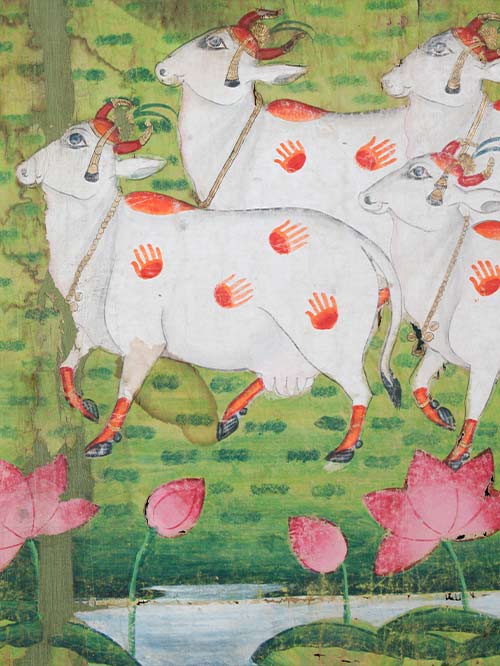
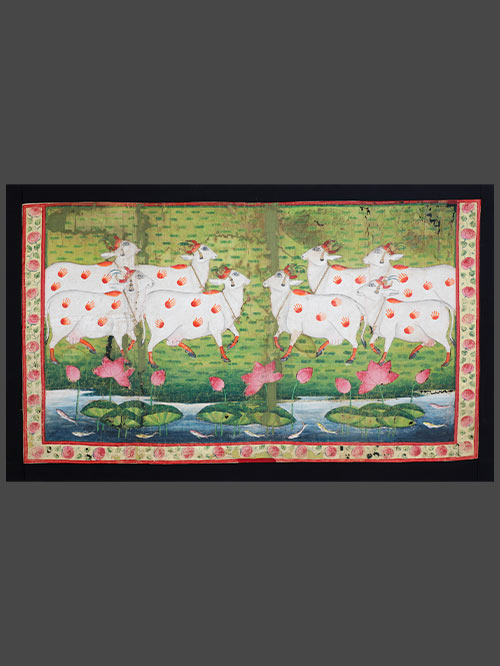
Nathdwara (Rajasthan)
Cotton, painted on pigments
An attractive small Pichhwai depicting eight white cows grouped in a meadow with a lotus and fish filled stream in the foreground. The cows are bedecked and have henna on their horns and hooves. Large handprints painted in saffron henna cover bodies. A floral border surrounds the panel. This pichhwai would have either accompanied a larger pichhwai in a prominent shrine or constituted part of a small domestic shrine.
Gopashtami is a festival that commemorates Krishna’s elevation from a young herder of calves to full cowherd. Krishna grows into the perfect cowherd, the one all the cows heed, answering to the golden strains of his flute. At Nathdwara the cows, decked in their finest, are brought into the haveli. There is a playful spirit about this festival that is well expressed in this pichhwai. The cows, gentle creatures with limpid eyes and expressive ears, are constant reminders of Vraja and Krishna’s childhood occupation as cowherd.
Size (cms): 75(H) x 124(W)
Size (inches): 29.5(H) x 49(W)
-
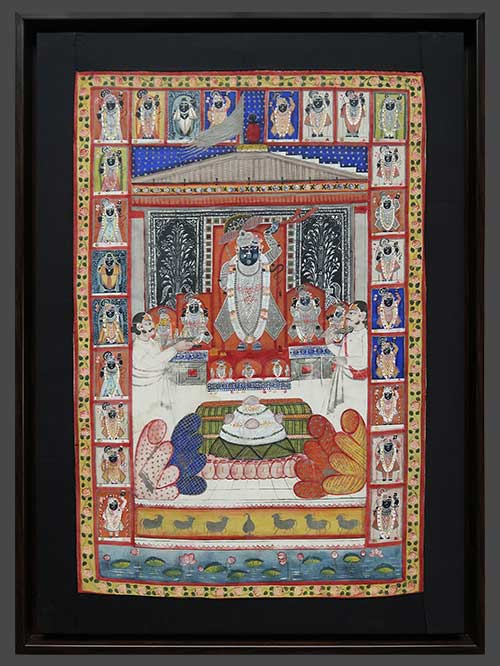

Nathdwara (Rajasthan)
Cotton, painted on pigments
A scarce small Pichhwai celebrating Sapta Swarupa Annakutotsava, with the central figure of Srinathji accompanied by his seven forms (Sapta Swarupa) and attended by two goswamis. Srinathji and the sath swarupa, are all richly adorned and bejewelled and they stand upon an elevated altar in front of a saffron covered thada vastra. A richly embroidered tree-of-life hanging encrusted with jewels and pearls is placed behind the shrine.
A veritable feast of chhappan bhoga (fifty-six offerings) in the form of large mounds of rice and curd, festooned with pink sweet meats are laid out in front of Srinathji. These offering commemorate the grand festival of Annakuta, the largest yearly festival celebrated at Nathdwara, which is held the day after Diwali. The festival is celebrated in recognition of an episode in the life of Krishna when he persuaded the villagers of Vraj to present their harvest offerings to the spirit of Mount Govardhana, instead of Indra. The mountains of rice symbolically represent Mount Govardhana which are topped by a sweet cake called gunja representing the head of Vishnu flanked by four more signifying the four ayudhyas or weapons of Vishnu.
The pichhwai is bordered by bands depicting Srinatji in twenty-four different Darshan attires on its sides and top and a row of nandis (cows) above a lotus filled lake below.
Size (cms): 81(H) x 59(W)
Size (inches): 32(H) x 23(W)









